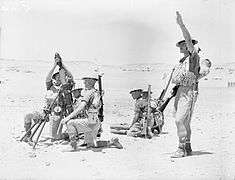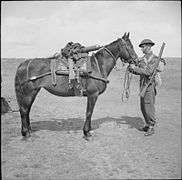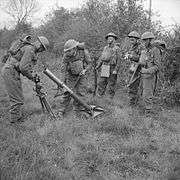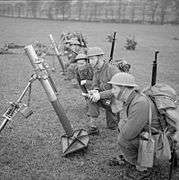Ordnance ML 3 inch mortar
| Ordnance ML 3-inch mortar | |
|---|---|
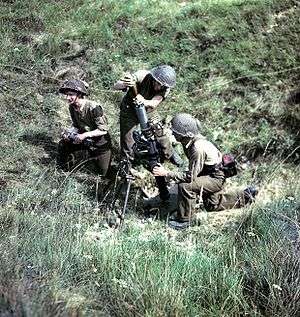 Canadian 3-inch mortar team, training post war | |
| Type | Mortar |
| Place of origin | United Kingdom |
| Service history | |
| Used by | See Users |
| Wars |
Second World War Indo-Pakistani War of 1947–1948[1] Korean War Sino-Indian War[2] Nigerian Civil War |
| Production history | |
| Designed | 1930s |
| Specifications | |
| Weight |
|
| Length | 4 ft 3 in (1.3 m) |
| Barrel length | 3 ft 11 in (1.19 m)[3] |
|
| |
| Shell | Bomb 10 lb (4.5 kg) |
| Calibre | 3.2 in (81 mm) |
| Elevation | +45° to +80° |
| Traverse | 11°[3] |
| Muzzle velocity | 650 ft/s (200 m/s) |
| Maximum firing range |
Mk.II: 1,600 yd (1,500 m) Mk.II LR: 2,800 yd (2,600 m) |
The Ordnance ML 3-inch mortar was the United Kingdom's standard mortar used by the British Army from the early 1930s to the late 1960s, superseding the Stokes mortar.[4] Although called the '3-inch mortar' by the British Army, its calibre was actually 3.209 in (81.5 mm).[5]
Design
The ML 3-inch mortar is a conventional Stokes-type mortar that is muzzle-loaded and drop-fired.
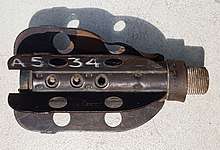
History
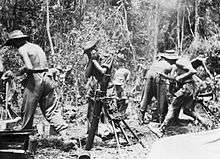
Based on their experience in World War I, the British infantry sought some sort of artillery for close support. The initial plan was for special batteries of artillery, but the cost was prohibitive and the mortar was accepted instead.
The Mark II mortar (Mark I was the Stokes) was adopted by the British Army in the early 1930s; and this was the standard British mortar when World War II broke out in September 1939. Experience in the early part of the war showed that, although the Mark II was reliable and sturdy, it did not have sufficient range compared to the German 81 mm s.GW.34 mortar. A series of experiments and trials using new propellants improved the range from 1600 yards to 2800 yards by about 1942; and, by 1943, the barrel, baseplate and sights had also been improved.[6][7]
The Mark II remained in service until replaced by the L16 81mm mortar in 1965.
Users
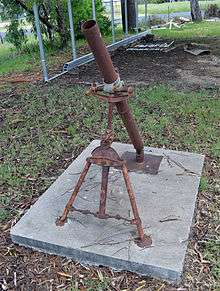
See also
- Stokes mortar : British WWI predecessor
- List of infantry mortars
Weapons of comparable role, performance and era
- 8 cm Granatwerfer 34 – German WWII equivalent
- 82-BM-37 & 82-PM-41 – Soviet WWII equivalents
- Brandt Mle 27/31 – French WWII equivalent
- M1 mortar – US WWII equivalent
- Type 97 81 mm infantry mortar – Japanese WWII equivalent
Gallery
References
Footnotes
- 1 2 Gates, Scott; Roy, Kaushik (2014). Unconventional Warfare in South Asia: Shadow Warriors and Counterinsurgency (1st ed.). Routledge. p. 94. ISBN 9781138252981.
- 1 2 Subramanian, L.N. (November–December 2000). "The Battle of Chushul". Bharat Rakshak Monitor. 3 (3). Archived from the original on 2 February 2007. Retrieved 24 April 2007.
- 1 2 Chamberlain, Peter (1975). Mortars and rockets. Gander, Terry. New York: Arco Pub. Co. p. 18. ISBN 0668038179. OCLC 2067459.
- ↑ Bishop, page 194.
- ↑ Handbook for the Ordnance, M.L 3-Inch Mortar, Mark II.
- ↑ Pamphlet No. 9, Mortar (3-inch) 1939.
- ↑ Pamphlet No. 9, Amendment No.1, Mortar (3-inch) 1943.
- ↑ Jowett, Philip (2016). Modern African Wars (5): The Nigerian-Biafran War 1967-70. Oxford: Osprey Publishing Press. pp. 22–23. ISBN 978-1472816092.
- ↑ Young, Peter (1972). The Arab Legion. Men-at-Arms. Osprey Publishing. p. 24. ISBN 0-85045-084-5.
- ↑ Jowett 2016, p. 20.
- ↑ Zaloga, Steven J. (1982). The Polish Army 1939–45. Men-at-Arms 117. Osprey Publishing. p. 21. ISBN 9780850454178.
- ↑ "WWII weapons in Yemen's civil war". wwiiafterwwii.wordpress.com. September 9, 2018.
- ↑ Vukšić, Velimir (July 2003). Tito's partisans 1941–45. Warrior 73. Osprey Publishing. p. 25. ISBN 978-1-84176-675-1.
Bibliography
- Bishop, Chris, The Encyclopedia of Weapons of WWII, Metro Books, New York, 2002, ISBN 1-58663-762-2.
- Boyd, David, British Mortars of the Second World War, www.wwiiequipment.com.au, retrieved 23 October 2016.
- War Office, Handbook for the Ordnance, M.L 3-Inch Mortar, Mark II, on Mounting, 3-inch Mortar, Mark I Land Service 1937, His Majesty's Stationery Office, London, 1937.
- War Office, Army Council, Small Arms Training, Volume I, Pamphlet No. 9, Mortar (3-inch) 1939, His Majesty's Stationery Office, London, 1937.
- War Office, Army Council, Small Arms Training, Volume I, Pamphlet No. 9, Amendment No.1, Mortar (3-inch) 1943, His Majesty's Stationery Office, London, 1937.
| Wikimedia Commons has media related to Ordnance ML 3 inch Mortar. |

